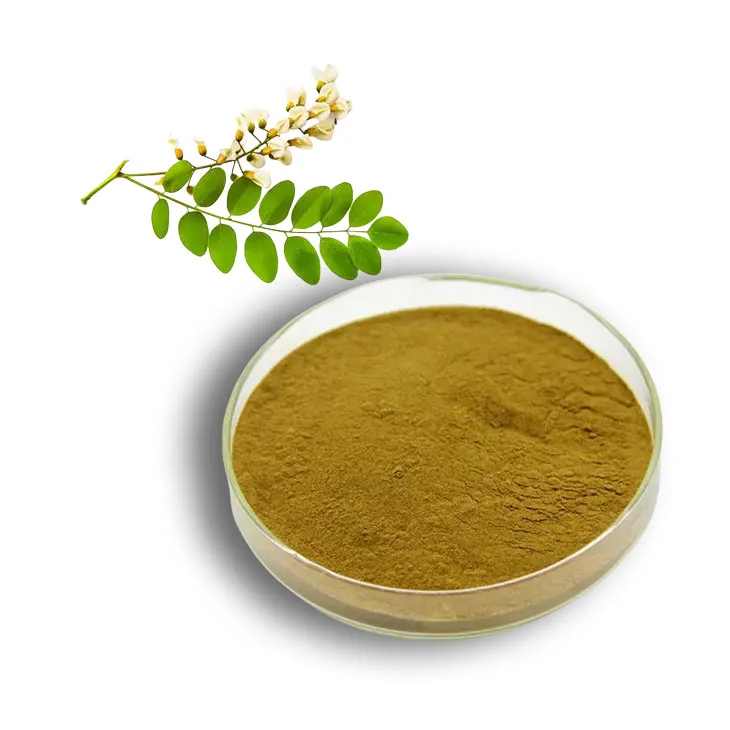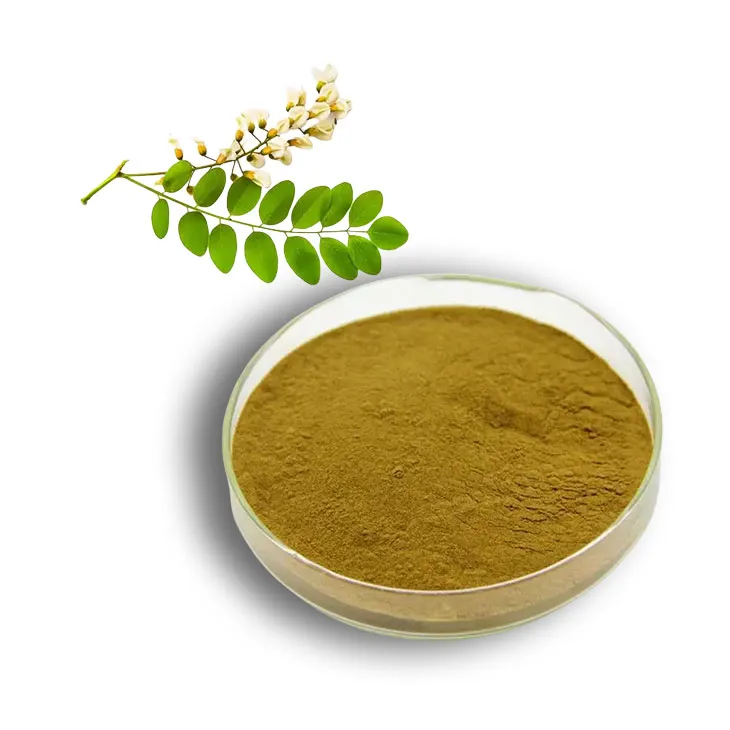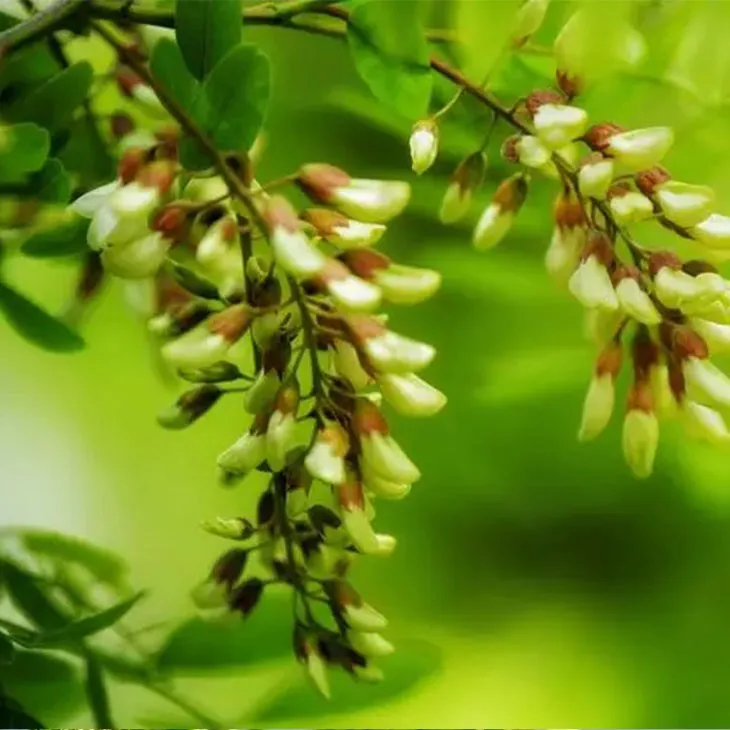- 0086-571-85302990
- sales@greenskybio.com
Sophora japonica Flower Extract: From Leaves to Extraction.
2024-11-12

1. Introduction
Sophora japonica, a plant with a long history of use in traditional medicine, has been attracting increasing attention in recent years due to its potential applications in various fields. The extraction of useful components from its leaves is a crucial step in harnessing its benefits. This article aims to provide a comprehensive overview of the process, from the characteristics of the leaves to the extraction methods and the applications of the resulting extracts.

2. The Unique Properties of Sophora japonica Leaves
2.1 Chemical Composition Sophora japonica leaves are rich in a variety of chemical compounds. They contain flavonoids, such as rutin, which is well - known for its antioxidant properties. These flavonoids play a significant role in protecting cells from oxidative damage caused by free radicals. In addition, the leaves also contain alkaloids, which may have certain pharmacological effects. For example, some alkaloids in Sophora japonica leaves have been studied for their potential anti - inflammatory and antibacterial activities.
2.2 Physical Characteristics The leaves of Sophora japonica are typically small to medium - sized, with a smooth or slightly serrated margin. They have a characteristic green color, which is related to the presence of chlorophyll. The texture of the leaves can affect the extraction process, as it may influence the penetration of solvents during extraction.

3. Extraction Methods
3.1 Solvent Extraction
3.1.1 Selection of Solvents Solvent extraction is one of the most commonly used methods for extracting components from Sophora japonica leaves. Different solvents can be selected based on the solubility of the target compounds. For example, ethanol is often used because it can dissolve a wide range of flavonoids and alkaloids. Water can also be used as a solvent, especially for extracting water - soluble compounds. However, water extraction may also extract more impurities compared to organic solvents.
3.1.2 Extraction Process The solvent extraction process typically involves several steps. First, the Sophora japonica leaves are dried and ground into a fine powder. This increases the surface area of the leaves, facilitating better contact with the solvent. Then, the powdered leaves are mixed with the selected solvent in a suitable container. The mixture is usually stirred or shaken for a certain period of time, usually several hours to days, to ensure sufficient extraction. After that, the mixture is filtered to separate the liquid extract from the solid residue.
3.2 Supercritical Fluid Extraction
3.2.1 Principle of Supercritical Fluid Extraction Supercritical fluid extraction (SFE) is a more advanced extraction method. Supercritical fluids, such as supercritical carbon dioxide (sc - CO₂), have unique properties. They possess the diffusivity of gases and the density of liquids, which allows for efficient extraction. In the case of Sophora japonica leaves, sc - CO₂ can selectively extract certain components without leaving behind harmful residues, as it is a clean and non - toxic solvent.
3.2.2 SFE Process for Sophora japonica Leaves The SFE process for Sophora japonica leaves involves placing the dried leaves in an extraction vessel. The supercritical carbon dioxide is then pumped into the vessel at a specific pressure and temperature. The pressure and temperature are carefully controlled to maintain the supercritical state of carbon dioxide. The components from the leaves are dissolved in the supercritical fluid, and then the extract is separated from the fluid by reducing the pressure, which causes the carbon dioxide to return to its gaseous state, leaving behind the extracted components.

4. Quality Control in the Extraction Process
4.1 Purity of the Extract Ensuring the purity of the Sophora japonica leaf extract is crucial. Impurities in the extract can affect its performance in various applications. For solvent extraction, proper filtration and purification steps are necessary. In supercritical fluid extraction, careful control of the extraction conditions can help to obtain a purer extract. Analytical techniques such as high - performance liquid chromatography (HPLC) can be used to measure the purity of the extract and identify the presence of any unwanted compounds.
4.2 Yield of the Extract Maximizing the yield of the extract is also an important aspect of quality control. The yield can be affected by various factors, including the extraction method, the quality of the raw materials (i.e., the Sophora japonica leaves), and the extraction conditions. By optimizing these factors, a higher yield of the desired components can be achieved. For example, adjusting the solvent - to - material ratio in solvent extraction or the pressure and temperature in supercritical fluid extraction can have an impact on the yield.
5. Potential Applications of Sophora japonica Leaf Extracts
5.1 In Medicine
5.1.1 Anti - inflammatory Effects The flavonoids and alkaloids present in Sophora japonica leaf extracts may have anti - inflammatory effects. They can potentially be used to treat inflammatory diseases such as arthritis. Studies have shown that certain compounds in the extract can inhibit the production of inflammatory cytokines, thereby reducing inflammation in the body.
5.1.2 Antioxidant Activity As mentioned earlier, the presence of flavonoids like rutin gives the extract strong antioxidant properties. Antioxidants are important in preventing oxidative stress - related diseases, such as cardiovascular diseases and certain cancers. The extract can scavenge free radicals in the body, protecting cells from damage.
5.2 In Cosmetics
5.2.1 Skin - Whitening Effects Sophora japonica leaf extract may have skin - whitening effects. Some of the compounds in the extract can inhibit the activity of tyrosinase, an enzyme involved in the production of melanin. By reducing melanin production, the extract can help to lighten the skin tone, making it a potential ingredient in skin - whitening cosmetics.
5.2.2 Anti - aging Properties The antioxidant activity of the extract also contributes to its anti - aging properties. It can protect the skin from oxidative damage caused by environmental factors such as UV radiation and pollution. This helps to maintain the elasticity and smoothness of the skin, reducing the appearance of wrinkles and fine lines.
5.3 In Food
5.3.1 Natural Preservative The antibacterial and antioxidant properties of Sophora japonica leaf extract make it a potential natural preservative in the food industry. It can help to prevent the growth of bacteria and fungi in food products, thereby extending their shelf life. Additionally, as a natural ingredient, it is more acceptable to consumers who are increasingly interested in natural and healthy food products.
5.3.2 Flavor Additive The extract may also have a unique flavor that can be used as a flavor additive in certain foods. It can impart a subtle, herbal flavor to food products, enhancing their taste. However, further research is needed to fully understand its flavor - enhancing properties and to ensure its safety as a food additive.
6. Significance of High - Quality Extraction Processes
6.1 Maximizing Benefits High - quality extraction processes are essential for maximizing the benefits of Sophora japonica leaf extracts. A well - controlled extraction process can ensure a high yield of the desired components with high purity. This, in turn, can enhance the effectiveness of the extract in its various applications, whether in medicine, cosmetics, or food.
6.2 Ensuring Safety A high - quality extraction process also helps to ensure the safety of the extract. By removing impurities and contaminants, the risk of adverse reactions in applications such as medicine and cosmetics can be minimized. In the food industry, a safe extract is crucial to meet regulatory requirements and protect consumer health.
7. Conclusion
The extraction of components from Sophora japonica leaves is a complex but promising process. The unique properties of the leaves offer a rich source of valuable compounds. Through different extraction methods, such as solvent extraction and supercritical fluid extraction, these compounds can be obtained. High - quality extraction processes are crucial for ensuring the purity, yield, and safety of the extracts. The potential applications of Sophora japonica leaf extracts in medicine, cosmetics, and food are extensive, highlighting the importance of further research and development in this area.
FAQ:
What are the common extraction methods for Sophora japonica leaf extract?
There are several common extraction methods for Sophora japonica leaf extract. One is solvent extraction, which involves using solvents like ethanol or water to dissolve the active compounds from the leaves. Another method is supercritical fluid extraction, which uses supercritical fluids such as carbon dioxide under specific pressure and temperature conditions to extract the desired components. Maceration is also a traditional method, where the leaves are soaked in a solvent for a certain period to obtain the extract.
What are the unique properties of Sophora japonica leaves?
Sophora japonica leaves possess several unique properties. They contain various bioactive compounds such as flavonoids, alkaloids, and phenolic acids. These compounds are associated with antioxidant, anti - inflammatory, and antimicrobial activities. The leaves also have a characteristic chemical composition that gives them potential in different applications, for example, their flavonoid content can contribute to their medicinal properties and also play a role in cosmetics for skin health promotion.
What are the potential applications of Sophora japonica leaf extract in medicine?
In medicine, Sophora japonica leaf extract has potential applications. Due to its antioxidant and anti - inflammatory properties, it may be used in the treatment of certain inflammatory diseases. It could also have potential in the field of cardiovascular health, as some of its components may help in reducing blood lipid levels or improving blood vessel function. Additionally, its antimicrobial properties might be exploited for the development of new drugs to combat certain infections.
How does Sophora japonica leaf extract contribute to the cosmetics industry?
In the cosmetics industry, Sophora japonica leaf extract can contribute in multiple ways. Its antioxidant properties can help in protecting the skin from oxidative stress, which is associated with premature aging. The anti - inflammatory effects can soothe irritated skin. It can also be used in hair care products, as it may promote healthy hair growth and improve the overall condition of the hair due to its nutrient - rich composition.
What is the importance of high - quality extraction processes for Sophora japonica leaf extract?
High - quality extraction processes are crucial for Sophora japonica leaf extract. A proper extraction process ensures that the maximum amount of bioactive compounds are obtained from the leaves. This is important as these compounds are responsible for the various beneficial properties of the extract. Poor extraction methods may lead to the degradation or loss of these active components, reducing the effectiveness of the extract in different applications. Also, a high - quality extraction process helps in maintaining the purity and safety of the extract, which is essential for its use in medicine, cosmetics, and food.
Related literature
- Studies on the Chemical Constituents of Sophora japonica Leaves"
- "Extraction Techniques and Bioactive Compounds of Sophora japonica: A Review"
- "The Potential of Sophora japonica Leaf Extract in Cosmetics: A Comprehensive Analysis"
- ▶ Hesperidin
- ▶ Citrus Bioflavonoids
- ▶ Plant Extract
- ▶ lycopene
- ▶ Diosmin
- ▶ Grape seed extract
- ▶ Sea buckthorn Juice Powder
- ▶ Fruit Juice Powder
- ▶ Hops Extract
- ▶ Artichoke Extract
- ▶ Mushroom extract
- ▶ Astaxanthin
- ▶ Green Tea Extract
- ▶ Curcumin
- ▶ Horse Chestnut Extract
- ▶ Other Product
- ▶ Boswellia Serrata Extract
- ▶ Resveratrol
- ▶ Marigold Extract
- ▶ Grape Leaf Extract
- ▶ New Product
- ▶ Aminolevulinic acid
- ▶ Cranberry Extract
- ▶ Red Yeast Rice
- ▶ Red Wine Extract
-
Eyebright Extract
2024-11-12
-
Almond Extract Powder
2024-11-12
-
Camu Camu Extract
2024-11-12
-
Genistein
2024-11-12
-
Troxerutin
2024-11-12
-
Chasteberry Extract
2024-11-12
-
Artichoke Extract
2024-11-12
-
Tongkat Ali Extract
2024-11-12
-
Centella Asiatica Extract
2024-11-12
-
Bamboo Leaf extract
2024-11-12





















